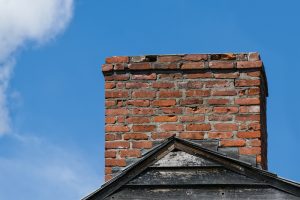As a homeowner, maintaining your chimney is crucial to ensuring the safety and longevity of your home. One vital component that often goes overlooked is the chimney crown. We’ve seen firsthand how essential a well-maintained chimney crown is for the overall health of your chimney system. In this blog post, we’ll delve into what a chimney crown is, how it can sustain damage over the years, and how to determine when it’s time for a chimney crown replacement in Minneapolis. If your chimney has other visible wear and tear, you may also benefit from a full chimney restoration to address more widespread issues.
Understanding What a Chimney Crown Is
The chimney crown is the topmost part of your chimney, covering the masonry and flue opening. It’s designed to protect your chimney from water damage by directing rainwater away from the flue and masonry. Made from materials like concrete, metal, or stone, the chimney crown acts as a shield, preventing moisture from seeping into the bricks and mortar.
Common Chimney Crown Damage Causes
Over time, even the most durable chimney crowns can suffer from wear and tear due to various factors:
- Weather Exposure: Constant exposure to harsh weather conditions like rain, snow, and freeze-thaw cycles can cause cracks and deterioration in the crown material.
- Poor Construction: If the chimney crown was not constructed properly, it might not provide adequate protection. A poorly built crown may lack the necessary slope or overhang, leading to water accumulation and increased susceptibility to damage.
- Aging Materials: Like all building materials, the components of your chimney crown will degrade over time. Concrete can crack, metal can rust, and stone can erode, all of which compromise the crown’s integrity.
- Environmental Factors: Factors such as salt air in coastal regions or pollution in urban areas can accelerate the wear and tear on your chimney crown, leading to faster deterioration. In some cases, especially in older homes, this kind of weathering can lead to leaky chimney problems if not addressed promptly.
How to Know If Your Chimney Crown Needs Replacing
Recognizing the signs of a damaged chimney crown early can save you from more extensive (and expensive) repairs down the line. Here are some key indicators that it’s time to call in the professionals:
- Visible Cracks: One of the most obvious signs of a damaged chimney crown is the presence of visible cracks. These can appear as hairline fractures or more substantial gaps. Any visible cracking should be addressed immediately, as it can quickly worsen with exposure to the elements.
- Water Leaks: If you notice water leaks inside your chimney or home, it could be a sign that your chimney crown is no longer providing adequate protection. Water stains on the ceiling near the chimney or on the walls can indicate that the crown is compromised.
- Erosion or Spalling Bricks: When the chimney crown fails, it can lead to water seeping into the masonry below, causing the bricks to erode or spall (flake off). This not only affects the aesthetic of your chimney but also its structural integrity.
- Rust Stains: For metal chimney crowns, rust stains are a clear sign of deterioration. Rust weakens the metal, making it less effective at protecting your chimney from moisture. If you’ve already observed this or other related symptoms, it’s a good idea to schedule an inspection. Learn about what happens during a Level 3 chimney inspection to understand how professionals assess the internal and external structure before recommending repairs or replacements.
- Damaged Flue Liner: A damaged or deteriorating flue liner can also indicate issues with the chimney crown. If the flue liner is cracked or damaged, it might be due to water infiltration caused by a compromised crown.
Why a Professional Should Replace Your Chimney Crown
If you observe any of the signs mentioned above, it’s crucial to contact a professional chimney contractor as soon as possible. At 2nd Generation Chimneys, our experts can conduct a thorough inspection to assess the condition of your chimney crown and determine the best course of action. If you suspect your chimney crown needs attention, don’t hesitate to contact us for a comprehensive inspection and reliable service.
2nd Generation Chimneys, Inc. serves Minneapolis, St. Paul and the Surrounding Communities. Contact us today for all your chimney repair and replacement needs.

